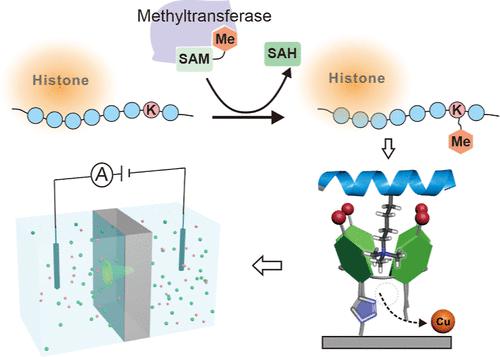当前位置:
X-MOL 学术
›
Anal. Chem.
›
论文详情
Our official English website, www.x-mol.net, welcomes your
feedback! (Note: you will need to create a separate account there.)
Nanofluidic Device for Detection of Lysine Methylpeptides and Sensing of Lysine Methylation
Analytical Chemistry ( IF 6.7 ) Pub Date : 2023-05-04 , DOI: 10.1021/acs.analchem.3c01074 Yuting Xiong 1 , Minmin Li 1, 2 , Yuchen Cao 2 , Zan Li 2 , Yongxin Chang 2 , Xinjia Zhao 2 , Guangyan Qing 2
Analytical Chemistry ( IF 6.7 ) Pub Date : 2023-05-04 , DOI: 10.1021/acs.analchem.3c01074 Yuting Xiong 1 , Minmin Li 1, 2 , Yuchen Cao 2 , Zan Li 2 , Yongxin Chang 2 , Xinjia Zhao 2 , Guangyan Qing 2
Affiliation

|
Protein methylation is the smallest possible yet vitally important post-translational modification (PTM). This small and chemically inert addition in proteins makes the analysis of methylation more challenging, thus calling for an efficient tool for the sake of recognition and detection. Herein, we present a nanofluidic electric sensing device based on a functionalized nanochannel that was constructed by introducing monotriazole-containing p-sulfonatocalix[4]arene (TSC) into a single asymmetric polymeric nanochannel via click chemistry. The device can selectively detect lysine methylpeptides with subpicomole sensitivity, distinguish between different lysine methylation states, and monitor the lysine methylation process by methyltransferase at the peptide level in real time. The introduced TSC molecule, with its confined asymmetric configuration, presents the remarkable ability to selectively bind to lysine methylpeptides, which, coupled with the release of the complexed Cu ions, allows the device to transform the molecular-level recognition to the discernible change in ionic current of the nanofluidic electric device, thus enabling detection. This work could serve as a stepping stone to the development of a new methyltransferase assay and the chemical that specifically targets lysine methylation in PTM proteomics.
中文翻译:

用于检测赖氨酸甲基肽和感测赖氨酸甲基化的纳米流体装置
蛋白质甲基化是最小的可能但至关重要的翻译后修饰 (PTM)。蛋白质中这种小的化学惰性添加物使甲基化分析更具挑战性,因此需要一种有效的工具来进行识别和检测。在此,我们提出了一种基于功能化纳米通道的纳米流体电传感装置,该纳米通道是通过引入含单三唑的p-sulfonatocalix[4]arene (TSC) 通过点击化学进入单个不对称聚合物纳米通道。该装置可以选择性地检测亚皮摩尔灵敏度的赖氨酸甲基肽,区分不同的赖氨酸甲基化状态,并实时监测甲基转移酶在肽水平上的赖氨酸甲基化过程。引入的 TSC 分子具有受限的不对称构型,具有选择性结合赖氨酸甲基肽的显着能力,再加上络合的 Cu 离子的释放,使该装置能够将分子水平的识别转化为离子的可辨别变化纳米流体电子设备的电流,从而能够进行检测。
更新日期:2023-05-04
中文翻译:

用于检测赖氨酸甲基肽和感测赖氨酸甲基化的纳米流体装置
蛋白质甲基化是最小的可能但至关重要的翻译后修饰 (PTM)。蛋白质中这种小的化学惰性添加物使甲基化分析更具挑战性,因此需要一种有效的工具来进行识别和检测。在此,我们提出了一种基于功能化纳米通道的纳米流体电传感装置,该纳米通道是通过引入含单三唑的p-sulfonatocalix[4]arene (TSC) 通过点击化学进入单个不对称聚合物纳米通道。该装置可以选择性地检测亚皮摩尔灵敏度的赖氨酸甲基肽,区分不同的赖氨酸甲基化状态,并实时监测甲基转移酶在肽水平上的赖氨酸甲基化过程。引入的 TSC 分子具有受限的不对称构型,具有选择性结合赖氨酸甲基肽的显着能力,再加上络合的 Cu 离子的释放,使该装置能够将分子水平的识别转化为离子的可辨别变化纳米流体电子设备的电流,从而能够进行检测。

































 京公网安备 11010802027423号
京公网安备 11010802027423号